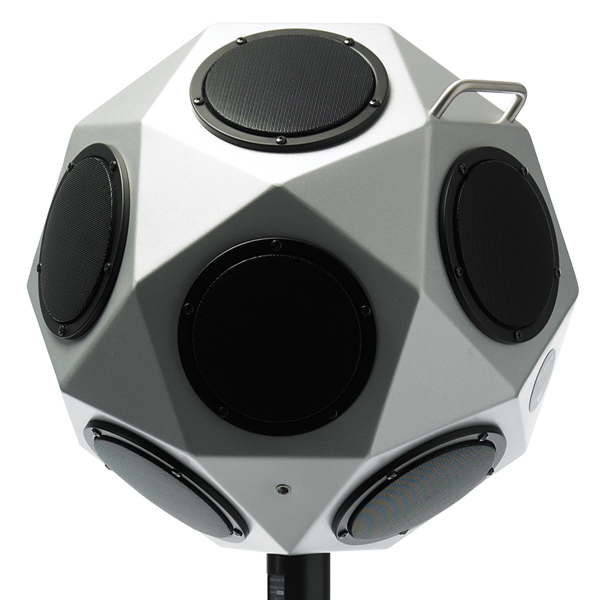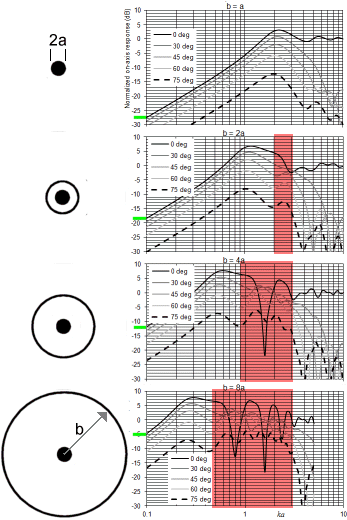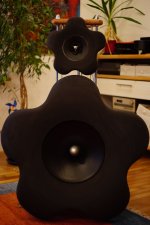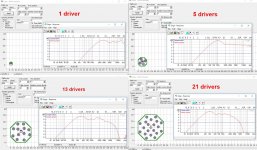Charlie, what are your thoughts about Gerrit's reversed drivers?
I'm not quite sure what you are referring to. Is it the "Four Vifa TC9 in an alternating arrangement" where two of the four are mounted backwards?
Dear All,
yes, this is quite an interesting thread, and I respect Charlie´s pursuit a lot, as I myself will never accomplish this goal with an 18-inch woofer and an 8-inch wideband driver...
So of course I ask myself if I have done it wrong?
It would be very interesting to judge pros and cons of one approach versus the other, but difficult to do.
I might add some personal experience with low OB bass in my room, and yes, I´m one of those 1919 guys who still use passive filters, have the loudspeakers well out into the room, and use only one amplifier per channel...
Deep OB bass is certainly possible, and even without DSP, even nude driver, but then efficiency is gone.
I arrived at a baffle of effectively 930 mm path length. The pair of AE Dipole 18-8 will move nearly 3 liters of air in each direction, and that accounts for an in-room respone down to 25 Hz, with an efficiency of around 90 dB/2.8 Volts (coils in parallel, of course).
Maximum level is high, I measured up to 110 dB at listening position while enjoying Jonas Hellborgs "Silent life" with tap fully opened, loud enough for me. And no, I have no neighbours...
All the best
Mattes
yes, this is quite an interesting thread, and I respect Charlie´s pursuit a lot, as I myself will never accomplish this goal with an 18-inch woofer and an 8-inch wideband driver...
So of course I ask myself if I have done it wrong?
It would be very interesting to judge pros and cons of one approach versus the other, but difficult to do.
I might add some personal experience with low OB bass in my room, and yes, I´m one of those 1919 guys who still use passive filters, have the loudspeakers well out into the room, and use only one amplifier per channel...
Deep OB bass is certainly possible, and even without DSP, even nude driver, but then efficiency is gone.
I arrived at a baffle of effectively 930 mm path length. The pair of AE Dipole 18-8 will move nearly 3 liters of air in each direction, and that accounts for an in-room respone down to 25 Hz, with an efficiency of around 90 dB/2.8 Volts (coils in parallel, of course).
Maximum level is high, I measured up to 110 dB at listening position while enjoying Jonas Hellborgs "Silent life" with tap fully opened, loud enough for me. And no, I have no neighbours...
All the best
Mattes
Attachments
Thinking this further, the optimal baffle width (including the driver's own radiating area) would need to change contiuously with frequency, inveresly proportional, that is. Sadly, impossible to realize, therefore the need to split into freq bands for several drivers in an effort to stay below dipole peak to avoid lobing. With front-back symmetric drivers all positioned at one location, coaxially. Again, no way to get there, not even close.Also, if your question was for me, the "optimal" baffle shape is NO BAFFLE, period.
Out-of-the-box idea: we could model a theoretical optimal FR dipole speaker and calculate the complex SPL functions that would be present at all the points of a bigger sphere covering the whole speaker, then materialize the sphere packed with smal fullrange drivers, feeding them with the properly shaped signals (mag and phase changes as required). Think of a dodocaeder speaker with separate signal channel procesing for each driver which would recreate the complete sound wave field that would be present from an idealized dipole. Or cardiod, or whatever target we want to establish (incl. morphing from monopole to cadioid to dipole vs. frequency, for exampe). The more I think about this the more I like it. Except for the extreme frequency ends this really should deliver excellent, if not stellar results with regard to really clean and well-definded point-source radiation patterns
Lobing is smoothed by using rectangular baffle, off-centre driver, etc, so as to vary the distance between the point sourcesThinking this further, the optimal baffle width (including the driver's own radiating area) would need to change contiuously with frequency, inveresly proportional, that is. Sadly, impossible to realize, therefore the need to split into freq bands for several drivers in an effort to stay below dipole peak to avoid lobing.
Thinking this further, the optimal baffle width (including the driver's own radiating area) would need to change contiuously with frequency, inveresly proportional, that is.
But wouldn't a random-like baffle - like Mattes in post 65 - be the correct design? That's also what scottjoplin is suggesting in previous post.
As far as "thinking out of the box", sure hard to start thinking about things stochastically (in audio and life otherwise).
B.
True but this is only a symptoms treatment. The "pulsating sphere" concept (with indivdually shaped movement of it' surface segments) would avoid the root cause of the problem. The uniformly pulsating sphere of a given size is known to be a very good approximation of a perfect monopole point source (in the far field, say, >5x diameter away) so I see no reason why any other radiation pattern wouldn't work as well. This is true soundfield synthesis.Lobing is smoothed by using rectangular baffle, off-centre driver, etc, so as to vary the distance between the point sources
Last edited:
See my response to his post above.But wouldn't a random-like baffle - like Mattes in post 65 - be the correct design? That's also what scottjoplin is suggesting in previous post.
An Edge excercise with KSTR's idea. The program didn't behave right without a baffle but I varied it's size. All 21 full-range drivers should be connected to a metal grid/web which is acoustcally transparent. A 4-way crossover with just lowpass at different frequencies would do. Center unit might benefit of having highpass too.
Still in real life we are in trouble below 50Hz and above 5kHz. Even B&G Neo3PDR has frame of 7x6cm, so dipole summation doesn't work above 5-6kHz.
Still in real life we are in trouble below 50Hz and above 5kHz. Even B&G Neo3PDR has frame of 7x6cm, so dipole summation doesn't work above 5-6kHz.
Attachments
I understand that. It's an interesting exercise, and theoretically the answer exists. I agree it probably is helpful to have equal radiation front to back, but in reality the dispersion and reflections are not going to give predictable peaks and nulls at any points in space.True but this is only a symptoms treatment. The "pulsating sphere" concept (with indivdually shaped movement of it' surface segments) would avoid the root cause of the problem. The uniformly pulsating sphere of a given size is known to be a very good approximation of a perfect monopole point source (in the far field, say, >5x diameter away) so I see no reason why any other radiation pattern wouldn't work as well. This is true soundfield synthesis.
Last edited:
Think of a basket-ball sized sphere with lots of 2" FR drivers mounted onto its solid surface (not an open grid frame, a misunderstanding there?), tightly packed. Plus the FR drivers having proper small waveguides/phaseplugs so that they array up nicely.
With all drivers fed the same signal this would be the best starting point, we won't get any closer to point source omni given that there must be quite a bit of total radiation area which limits minimum size for given max SPL target. Then EQ to flat far field. Measure and re-iterate where needed.
Next step is implement the modifying transfer function for each driver to shape the far field radtiation pattern to point-source dipole or whatever, these will be analytical functions, not derived from any measurement and so this would be a very clean implementation in my thinking.
I feel that this is almost impossible to implement in DIY really well unless using heavy 3D-modelling and -printing of the enclosure elements. Then again, as a good model of the real goal it certainly does well. Use the dipole concept without having any drivers to run in a physical dipole enviroment themselves sure could be a valid alternative approach.
With all drivers fed the same signal this would be the best starting point, we won't get any closer to point source omni given that there must be quite a bit of total radiation area which limits minimum size for given max SPL target. Then EQ to flat far field. Measure and re-iterate where needed.
Next step is implement the modifying transfer function for each driver to shape the far field radtiation pattern to point-source dipole or whatever, these will be analytical functions, not derived from any measurement and so this would be a very clean implementation in my thinking.
I feel that this is almost impossible to implement in DIY really well unless using heavy 3D-modelling and -printing of the enclosure elements. Then again, as a good model of the real goal it certainly does well. Use the dipole concept without having any drivers to run in a physical dipole enviroment themselves sure could be a valid alternative approach.
My excersice was dipole, flat.
Spherical omni speakers do exist, they can be found in some discoes and in acoustician's storage. But I don't believe that a sphere can be made to radiate as pure dipole, even theoretically, because of it's dimensions.
https://www.bksv.com/en/products/transducers/acoustic/sound-sources/omni-power-light-4292

Spherical omni speakers do exist, they can be found in some discoes and in acoustician's storage. But I don't believe that a sphere can be made to radiate as pure dipole, even theoretically, because of it's dimensions.
https://www.bksv.com/en/products/transducers/acoustic/sound-sources/omni-power-light-4292

Last edited:
A report by the textbook obsessed
The front-to-back cancellation does indeed occur. It's a considerable amount, but it's not 100% cancellation. It will varying to some degree, according to the very many variables in play. It will vary according to the location of the listener's ear. It will be frequency dependent according to it's proximity to a boundary, or boundaries. No amount of wishful thinking or slander against the laws of physics will change that.
This notion of superior transients is severely flawed. I can see however, how the mind's ear can be fooled. What the OB enthusiast is hearing, is the difference between a pressure device generation of a bass tone, and a velocity device's attempt at the same. the velocity device falls very short of being able to complete said tone. It does a partial job, and this is very often welcomed by the OB enthusiast, and mysteriously translates into "airy bass".
Having stated all that, there is no law against enjoying that particular type of sound, if that's your thing.
What I'd like to see is a simple real-world empirical test of the notion held firmly by some textbook obsessed people that the rear wave sneaks around and destroys the front wave. In the Olson's textbook, as I poorly recall it now, he used a circular baffle - obviously the worst kind for audio quality but showing the most dramatic cancellation.
As John Busch posted, "I think you are blinded by your perception of “acoustic short circuit” negatives, not the positives the “acoustic short circuit” can provide."
What really happens when you have a OB speaker in some proximity to a wall? Does the textbook model predominate or are the waves all dancing about in random phase?
Seems an easy question for somebody in some room to measure.
Since I believe the random-wave outcome (and have experience as my guide), I think it would be great to have the hobgoblin of wave annihilation put to rest... or at least evaluated properly.
B.
The front-to-back cancellation does indeed occur. It's a considerable amount, but it's not 100% cancellation. It will varying to some degree, according to the very many variables in play. It will vary according to the location of the listener's ear. It will be frequency dependent according to it's proximity to a boundary, or boundaries. No amount of wishful thinking or slander against the laws of physics will change that.
This notion of superior transients is severely flawed. I can see however, how the mind's ear can be fooled. What the OB enthusiast is hearing, is the difference between a pressure device generation of a bass tone, and a velocity device's attempt at the same. the velocity device falls very short of being able to complete said tone. It does a partial job, and this is very often welcomed by the OB enthusiast, and mysteriously translates into "airy bass".
Having stated all that, there is no law against enjoying that particular type of sound, if that's your thing.
...................there it is, that claim: "grossly inferior"...........................Scott…. Your thoughts and conclusions make a lot of sense. However, we need to focus on outcomes…. Yes, you can get a lot of output from a quality 18” woofer employed as a mono-pole source (closed, ported or horn loaded boxes of various alignments). I build a lot of box speaker designs too. Be they pro or residential.
One thing I would like you to do, just for giggles. Design a subwoofer, 18” class driver of course, that will play flat to 32 Hz with a net efficiency of at least 1% (92 dbw) capable of delivering a minimum of 1 acoustic watt (109 db) at 32 Hz at one meter without exceeding Xmax. (Half space mesurement) Make sure it can do that sitting on the floor away from the rear wall, say 24” to minimize standing waves (exciting the room). Plug and play. No EQ other than passive. Something you can drive with any competent HiFi stereo amplifier.
I think you may be surprised at how large the box is going to be. And the bass quality it will deliver in a typical residential environment will be, based on many years of experience, grossly inferior to what an OB can provide.
Driver details please, website, price, reviews....?
Thanks.
Alex.
I realized right way; this was a TALL ORDER by John ! I knew it was going to be close, but I started scanning through a few pro 18's to see if perhaps one would fit. I stopped at the 18HO1030, and ran the numbers. Use a 9 inch diameter port, and figure the box size to be somewhere between 7 and 8 cubic feet. The proper enclosure is far more advanced than a simple 3/4" plywood attempt. This driver is not cheap, like I stated before. $425 (approx)
FaitalPRO | LF Loudspeakers | 18HP1030
Again, think of it as soundfield synthesis. Take the idealized point source infinitesimal small dipole and model its soundfield at a distance r. The field is comprised of four-dimensional values, the SPL pressure scalar and the SPL velocity 3D-vector which is easy (normal to the surface) and not relevant anyway. If the sphere surface is modulated (deformed) properly it act as "open window" for the ideal dipole's radiation, no reflections of any sort taking place, hence if we recreate this exact motion of small sphere segments the emitted sound field must be identical.Spherical omni speakers do exist, they can be found in some discoes and in acoustician's storage. But I don't believe that a sphere can be made to radiate as pure dipole, even theoretically, because of it's dimensions.
^An almost infinitely small dipole radiator is mute. Everything gets cancelled then. When diameter grows, high frequencies won't get nulled anymore and gradually we start to see typical spl response on-and off-axis.

This is told in many articels and studies by various researchers, eg. Tim Mellow published also openly. Referenced by eg. Rudolf Finke.

This is told in many articels and studies by various researchers, eg. Tim Mellow published also openly. Referenced by eg. Rudolf Finke.
Last edited:
The front-to-back cancellation does indeed occur. It's a considerable amount, but it's not 100% cancellation. It will varying to some degree, according to the very many variables in play. It will vary according to the location of the listener's ear. It will be frequency dependent according to it's proximity to a boundary, or boundaries. No amount of wishful thinking or slander against the laws of physics will change that.
That's not quite right. I think your mental image of the "dreaded considerable front-to-back cancellation" gives you much grief. Let me point out some aspects that may make you better understand why the situation is not so bad.
The amount of front-to-back cancellation IS frequency dependent (ignoring walls and boundaries for a moment). In fact at some frequency the cancellation actually becomes "superposition" meaning that the front-to-back waves are 100% IN PHASE and add to +6dB. This happens at the dipole peak. Here the dipole is actually radiating MORE POWER than a single monopole of the same driver cone area AND the on axis SPL is +6dB. It is only when you start to slide down from there in frequency that you enter the dreaded "cancellation" regime where the frequency response (assuming infinite driver bandwidth) reaches 6dB/octave. It is noteworthy that (by theory) you have to go down to 0.17*v/D Hertz (v=345m/s, D=dipole front-to-back separation distance in m) before the on-axis SPL of the dipole drops back to the monopole SPL. It's about one third of the dipole frequency. If size the dipole so that you use it from the peak down, you will maximize the SPL capabilities and not suffer from excessive front-to-back cancellation. That's it in a nutshell. If you take a look at my example H-frame earlier in this thread you can see that the dipole SPL was only down 3dB on axis WRT monopole at 40Hz. I would not call that 'considerable".
It's only when the front-to-back pathlength is short that the dipole peak is high in frequency. If you also try to operate this driver too far below the dipole peak it will struggle to overcome all the cancellation. This is why some dipole systems sound "thin" in my opinion. The practical lower limit is around 80-100Hz. Below this you must start to make D larger.
Either you are willfully ignorant of the transient response resulting a bass reflex loudspeaker compared to a driver in free air, or you don't know what you are talking about. There is no escaping it, no matter how "properly designed" is the BR system. It has a sharper ultimate rolloff at the low end of the passband, and this causes poor transient response. It's physics and the effect it is worse the sharper the "knee" around the tuning frequency.This notion of superior transients is severely flawed.
On the other hand, a low Q (e.g. Q=0.5-0.7) driver in free air, or a baffle, or even an H-frame, will have exactly a second order response with that Q. Look it up. It's very clean. Also, there are no cabinet resonances and no port resonances, either. For these reasons I would have to say in relation to a BR a dipole is way out in front in terms of potential sound quality.
With this part I could not agree less.I can see however, how the mind's ear can be fooled. What the OB enthusiast is hearing, is the difference between a pressure device generation of a bass tone, and a velocity device's attempt at the same. the velocity device falls very short of being able to complete said tone. It does a partial job, and this is very often welcomed by the OB enthusiast, and mysteriously translates into "airy bass".
Having stated all that, there is no law against enjoying that particular type of sound, if that's your thing.
Yes, it is "my thing" and a thing for others too. We're happy to continue to enjoy it, thanks. And you can continue to enjoy your BR systems. They are probably as good as they can be designed and they seem to have you convinced that is the way to go. To each their own.
I think you have made your point and stated your opinion clear enough. You think dipole/OB systems are inferior and incapable and BR is awesome. Do you have anything else to add, perhaps some technical argument to support your claim, or are you just going to keep coming back to your personal opinion again and again?
maths and physics of ported and transmission line Vs sealed
I am not an expert but I saw this article a few years ago on another thread and I must admit it now makes perfect sense to me.... after reading about 10 times!
Any form of delayed resonance loading is fundamentally flawed, fact.
When it comes to "fooling the ear" the vast majority of home audio loudspeakers, commercial loudspeakers and live sound / event systems use this flawed method because its the cheapest way to achieve the highest SPL.... 99% of the public believe that this flawed sound is in fact accurate....
This is the "fools gold" and has spread like a cancer throughout the loudspeaker industry over the last 50 years or so and long passed the point of no return .... No way to break the vested interest / customer demand vicious circle......
Only the tiny minority of audio geeks (myself included!) are willing to explore and enjoy the true purity of sealed and or open baffle!!!
Cheers
Alex
I am not an expert but I saw this article a few years ago on another thread and I must admit it now makes perfect sense to me.... after reading about 10 times!
Any form of delayed resonance loading is fundamentally flawed, fact.
When it comes to "fooling the ear" the vast majority of home audio loudspeakers, commercial loudspeakers and live sound / event systems use this flawed method because its the cheapest way to achieve the highest SPL.... 99% of the public believe that this flawed sound is in fact accurate....
This is the "fools gold" and has spread like a cancer throughout the loudspeaker industry over the last 50 years or so and long passed the point of no return .... No way to break the vested interest / customer demand vicious circle......
Only the tiny minority of audio geeks (myself included!) are willing to explore and enjoy the true purity of sealed and or open baffle!!!
Cheers
Alex
Attachments
Last edited:
- Home
- Loudspeakers
- Multi-Way
- In Pursuit of a 20-20k Dipole Loudspeaker

